World War II records
Anyone who has researched the World War I records could well be disappointed at the comparatively limited availability of equivalent records for World War II.
The main reason is that records of Britain’s Armed Forces are still classified documents held by the Ministry of Defence.
If a member of your family was killed whilst serving in the British Army during WWII, they should be listed in the Army Roll of Honour, 1939–1945.
If you can locate the correct person you will be able to find out the date they died, their rank, the regiment they enlisted with, the theatre of war they served in (i.e. France and Belgium, Middle East, Africa), and the branch the person was serving with when they were killed.
Another record set from WWII that is freely searchable is British Army Prisoners of War, 1939–1945. If your ancestor was captured by the enemy, searching here can help you discover their rank, regiment, prisoner number, the type of camp they were held in and its location.
Finally, anyone with Jewish ancestors who survived the Holocaust, can search the names of over 60,000 people freed after the War in the record set Holocaust: Survivor names printed in Sharit Ha-Platah, 1946.
WWII Medals
No one person could receive more than 5 stars and the two medals. Also no one person was awarded more than one clasp to any one campaign star.
Some examples are
- A RAF pilot who qualified first for the Atlantic Star and then the France & Germany star, would wear the Atlantic Star with France and Germany clasp.
- A soldier who won the Pacific Star, and then gained the Burma Star, would wear the Pacific Star with Burma clasp.
The King’s Medal
The King’s medal was issued in two versions: The King’s Medal for Courage in the Cause of Freedom and the King’s Medal for Service in the Cause of Freedom.
The King’s Medal for Courage in the Cause of Freedom was introduced on 23 August 1945, and was used to recognise acts of courage by foreign civilians in the Allied cause. The medal’s obverse has the crowned profile of King George VI, with the text “The King’s Medal for Courage in the Cause of Freedom” on the reverse. The medal’s ribbon was white with two narrow blue stripes in the centre and two broad red stripes at the ribbon’s edges.
The King’s Medal for Service in the Cause of Freedom was introduced on 23 August 1945 to recognise acts of foreign civilians in less dangerous roles, but who nevertheless contributed to the British effort (such as fund raising activities). The medal’s obverse had the profile of King George VI, while the reverse had a medieval knight carrying a broken lance, receiving food from a woman. The ribbon was white with a central red bar, with a blue stripe on either side.
1939-45 Star
 Awarded for service in the Second World War between 3 September 1939 and 2 September 1945.
Awarded for service in the Second World War between 3 September 1939 and 2 September 1945.
The recipient was awarded this star if their service period was terminated by death or disability due to service. Also the award of a gallantry medal or MID also produced the award of this medal, regardless of their service duration.
Royal Navy personnel had to complete 6 months service afloat in active operational areas.
Army personnel had to complete 6 months service in an operational command.
Airborne troops qualified if they had participated in any airborne operations and had completed 2 months service in a fully operational unit.
RAF personnel had to participate in operations against the enemy providing that 2 months service had been completed in an operational unit. Non-aircrew personnel had to complete 6 months service in an area of operational army command.
Merchant Navy qualified if they completed 6 months service, and at least 1 voyage was made through an operational area.
Members of fighter aircraft crews who took part in the Battle of Britain (10 July to 31 October 1940) were awarded the “Battle of Britain” bar to this medal.
Atlantic Star
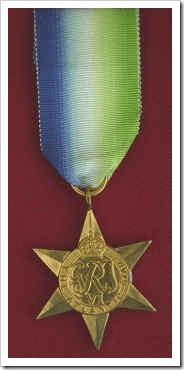 Awarded to commemorate the Battle of the Atlantic between 3 September 1939 to 8 May 1945. The 1939-45 Star must have been earned by 6, or 2 for aircrew, months service before commencing qualifying service for the Atlantic Star.
Awarded to commemorate the Battle of the Atlantic between 3 September 1939 to 8 May 1945. The 1939-45 Star must have been earned by 6, or 2 for aircrew, months service before commencing qualifying service for the Atlantic Star.
The recipient was awarded this star if their service period was terminated by their death or disability due to service. Also the award of a gallantry medal or MID also produced the award of this medal, regardless of their service duration.
Royal Navy and Merchant Navy personnel, together with Army and RAF personnel serving with either Naval service, had to complete 6 months service in the Atlantic, home waters, North Russia Convoys or South Atlantic waters west of longitude 20 degrees East.
RAF members of air crews who had completed 2 months service in active operations within the specified area, providing that service for the 1939-45 Star had been completed.
The possible Atlantic, Aircrew Europe and France & Germany Star combinations are (remembering that you only received the first two earned of these 3 stars)
- Aircrew Europe Star with France & Germany Clasp
- Aircrew Europe Star with Atlantic Clasp
- Atlantic Star with Aircrew Europe Clasp
- Atlantic Star with France & Germany Clasp
- France & Germany Star with Atlantic Clasp
Due to the different date ranges, you can’t have a Aircrew Europe clasp to a France and Germany Star.
Air Crew Europe Star
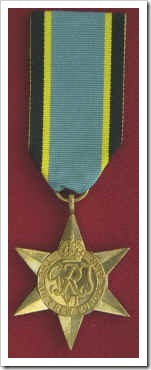 Awarded for operational flying from the UK over Europe, between the period 3 September 1939 to 5 June 1944 (outbreak of war until the start of the D-Day Normandy Invasion).
Awarded for operational flying from the UK over Europe, between the period 3 September 1939 to 5 June 1944 (outbreak of war until the start of the D-Day Normandy Invasion).
The recipient was awarded this star if their service period was terminated by their death or disability due to service. Also the award of a gallantry medal or MID also produced the award of this medal, regardless of their service duration.
RAF air crew had to complete 2 months service for this medal. However, this 2 months had to come after the service which entitled the person to the 1939-45 Star.
Army personnel qualified for this star if they served on air crew duties for 4 months, and that 2 months of this minimum 4 month period had been operational flying over Europe, with at least one operational sortie.
The possible Atlantic, Aircrew Europe and France & Germany Star combinations are (remembering that you only received the first two earned of these 3 stars)
- Aircrew Europe Star with France & Germany Clasp
- Aircrew Europe Star with Atlantic Clasp
- Atlantic Star with Aircrew Europe Clasp
- Atlantic Star with France & Germany Clasp
- France & Germany Star with Atlantic Clasp
Due to the different date ranges, you can’t have a Aircrew Europe clasp to a France and Germany Star.
Africa Star
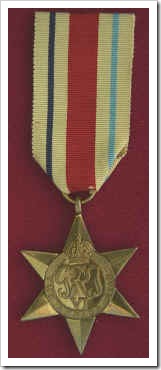 Awarded for 1 or more days service in North Africa between 10 June 1940 and 12 May 1943 (inclusive).
Awarded for 1 or more days service in North Africa between 10 June 1940 and 12 May 1943 (inclusive).
Royal and Merchant Navy qualified through service in the Mediterranean between these two dates. Also service in the campaigns in Abyssinia, Somaliland and Eritrea between 10 June 1940 and 27 September 1941 would qualify. Merchant Navy would also qualify with service in operations off the Moroccan coast between 8 November 1942 and 12 May 1943.
Army personnel had to enter North Africa on the establishment of an operational unit. Service in Abyssinia, Sudan, Somaliland and Eritrea also qualified. Service in West Africa did not qualify for this medal.
RAF personnel had to land in, or flown over, any of the areas previously mentioned.
There were 3 clasps for this medal: 8th Army, 1st Army and North Africa 1942-43. Only one bar could be worn on the medal. If a recipient was entitled to more than one clasp, they wore the first clasp gained.
Pacific Star
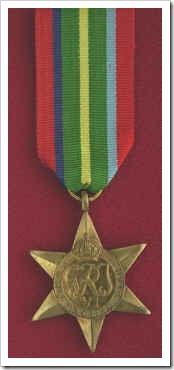 Awarded for service in the Pacific theatre of operations in the period 8 December 1941 to 2 September 1945, both dates inclusive.
Awarded for service in the Pacific theatre of operations in the period 8 December 1941 to 2 September 1945, both dates inclusive.
Royal and Merchant Navy service in the Pacific Ocean, South China Sea and the Indian Ocean east of a line running approximately south of Singapore qualified for this medal, providing that the 6 months service for the 1939-45 had already been earned. The restriction of previously earning the 1939-45 star did not apply for those who service started in the Pacific region after 2 March 1945. Naval personnel ashore had the same qualification requirements as the Army.
Army personnel had to serve in those territories which had been subjected to enemy or allied invasions. Service in Burma was excluded, as this area had its own star: The Burma Star. Service in China and Malaya between 8 December 1941 and 15 February 1942 was included. The Army had no prior time qualification.
RAF crews had to complete at least 1 operational sortie over the appropriate sea or land area.
If a serviceman qualified for both the “Pacific” and “Burma” Stars, they would be awarded the first gained star, with a clasp (or rosette on ribbon-alone) for the other earned Star.
Burma Star
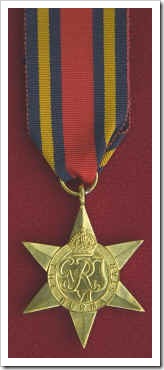 Awarded for service in the Burma Campaign between 11 December 1941 and 2 September 1945 (inclusive).
Awarded for service in the Burma Campaign between 11 December 1941 and 2 September 1945 (inclusive).
Royal and Merchant Navy personnel qualified through service in an area restricted to the Bay of Bengal, and enclosed by a line running from the southern-most point of Ceylon (now Sri Lanka) for a distance of 300 miles south, then to a point 300 miles west of the southern-most point of Sumatra, and continuing east to the western side of the Sunda Strait, including the Malacca Straits.
The 6 months service for the 1939-45 had to be earned, before service could count towards the Burma Star. This restriction did not apply for those personnel who entered qualifying service within the last 6 months, providing they did not enter another operational command.
Army personnel qualified through service in any part of Burma between 11 December 1941 and 2 September 1945. Service in the provinces of Bengal and Assam in the period 1 May 1942 to 2 September 1945 also qualified. Service in China and Malaya between 16 February 1942 and 2 September 1945 was also counted.
RAF aircrew had to make one operational sortie. RAF ground crew had the same restrictions as the Army.
If a serviceman qualified for both the “Burma” and “Pacific” Stars, they would be awarded the first gained star, with a clasp (or rosette on ribbon-alone) for the other earned Star.
Italy Star
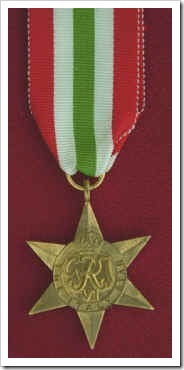 Awarded for operational service in Sicily or Italy during the period 11 June 1943 to 8 May 1945,
Awarded for operational service in Sicily or Italy during the period 11 June 1943 to 8 May 1945,
Royal and Merchant Navy service in the Mediterranean and the Aegean Sea and operations in and around the Dodecanese, Corsica, Greece, Sardinia and Yugoslavia after 11 June 1943 would qualify. The 6 months service for the 1939-45 had to be earned, before service could count towards the Burma Star. This restriction did not apply for those personnel who entered qualifying service within the last 6 months, providing they did not enter another operational command.
Naval shore-based personnel were covered by the Army qualification requirements.
Army personnel had no prior time qualification. The applicable operational area for Army personnel was Aegean, Dodecanese, Corsica, Greece, Sardinia, Yugoslavia and Elba between 11 June 1943 and 8 May 1945. Service in Sicily after 17 August 1943, Sardinia after 19 September 1943 and Corsica after 4 October 1943 did not qualify.
RAF personnel had no prior time qualification. Qualification involved participation in aircrew service within the Mediterranean theatre, including sorties from the Mediterranean area over Europe.
Entry into Austrian Territory during the last few days of the Second World War qualified for this star.
There were no clasps awared with the “Italy” Star.
France and Germany Star
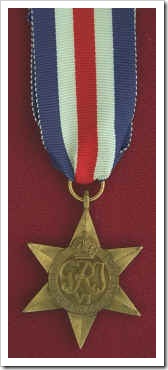 Awarded for service in France, Belgium, Holland or Germany in the period 6 June 1944 and 8 May 1945.
Awarded for service in France, Belgium, Holland or Germany in the period 6 June 1944 and 8 May 1945.
Royal and Merchant Navy qualification had no prior time qualification. The qualifying service area was the direct support of land operations in France, Belgium, Holland and Germany, in the North sea south of a line from the Firth of Forth to Kristiansand in the English Channel or the Bay of Biscay east of longitude 6 degrees W. Service off the coast of South France qualified for the Italy Star. Shore based Naval personnel were subject to the same qualification as the Army.
Army personnel had to take part in any operation on land in France, Belgium, Holland or Germany between 6 June 1944 and 8 May 1945.
RAF aircrew had to take part in an operation sortie over Europe between 6 June 1944 and 8 May 1945. RAF aircrew who flew operations over Europe, starting from Mediterranean bases, did not qualify for the France & Germany star but the Italy Star.
The possible Atlantic, Aircrew Europe and France & Germany Star combinations are (remembering that you only received the first two earned of these 3 stars)
- Aircrew Europe Star with France & Germany Clasp
- Aircrew Europe Star with Atlantic Clasp
- Atlantic Star with Aircrew Europe Clasp
- Atlantic Star with France & Germany Clasp
- France & Germany Star with Atlantic Clasp
Due to the different date ranges, you can’t have a Aircrew Europe clasp to a France and Germany Star.
Defence Medal
 This medal’s qualification requirements are numerous and varied. I have summarised them into the following points.
This medal’s qualification requirements are numerous and varied. I have summarised them into the following points.
- Service in the Forces in non-operational areas subjected to air attack or closely threatened, providing such service last at least three years.
- Non-operational service in the Forces overseas or outside the country of residence, providing that this service lasted for at least one year. If the territory was threatened by the enemy, or subjected to air raids, the duration requirement was reduced to six months.
- Civil defence in military operational areas providing these civil defence activities were not eligible for campaign stars.
- Members of any of the civilian services entitled to wear chevrons for their war service were eligible for this medal.
- Members of the Home Guard resident in the UK, who had completed at least three years service.
- Recipients of the George Cross or George Medal, regardless of their occupation, provided the George Cross or George Medal were won for service in civil defence.
War Medal
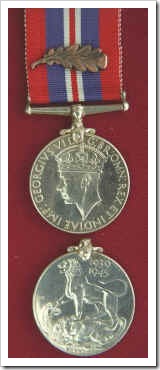 Awarded to all full-time personnel of the Armed Forces. Operational and non-operational service of at least 28 days counted. The Merchant Navy requirement stated that the 28 days minimum should be served at sea. The recipient was awarded this medal if their service period was terminated by their death, disability due to service or capture as a prisoner-of-war and their service qualified them for one of the stars. Also if the recipient had received one of the stars for a service period of less than 28 days, they were also awarded the War Medal.
Awarded to all full-time personnel of the Armed Forces. Operational and non-operational service of at least 28 days counted. The Merchant Navy requirement stated that the 28 days minimum should be served at sea. The recipient was awarded this medal if their service period was terminated by their death, disability due to service or capture as a prisoner-of-war and their service qualified them for one of the stars. Also if the recipient had received one of the stars for a service period of less than 28 days, they were also awarded the War Medal.
The War Medal shown above has the MID oak leaf attached to the ribbon.
The UK War Medals were made from cupro-nickel, whilst the Canadian War Medal are made from silver.
Those War Medals issued to UK personnel were not officially named. However, those issued to Australian and South African personnel were officially named.
General Service Medal
This page explains the history and details about The General Service Medal 1918-62. Medals, such as the GSM, were introduced to reward service in situations which were felt worthy of commemoration but of not a sufficient scale to justify individual campaign medals.
GSM 1918-62
The GSM was introduced in Army Order No. 4 dated 19 January 1923. This medal served as the Army and RAF equivalent of the NGS (Naval General Service Medal). The GSM was awarded for service in various parts of the world, except in India and East, West and Africa.
The medal is worn with a purple-coloured ribbon with one green stripe. After 11 August 1920, if the recipient was awarded a MID, then they were entitled to wear an oak leaf emblem on the medal’s ribbon.
This medal has a total of 16 clasps which commemorate the various actions. The individual clasps are listed in the following table. Click on the name to read about the particular clasp.
Palestine
This clasp was awarded for service in Palestine, under the League of Nations mandate, between the dates 19 April 1936 and 3 September 1939.
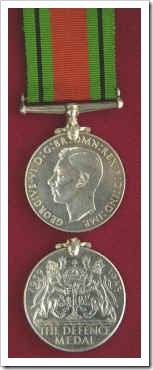
You must be logged in to post a comment.